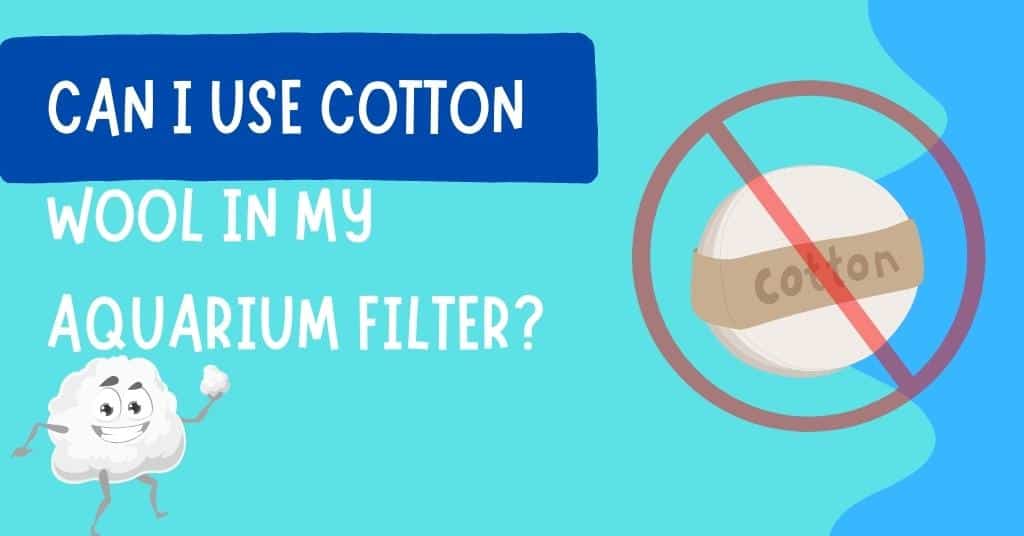Last Updated on December 12, 2021 by cmoarz
Need some new filter media to replace your old media, But don’t have any on hand? But what about that big pack of cotton wool you have in the bathroom, will that work? Is it safe? Can you use such cotton wool in your aquarium filter safely?

Can You Use Cotton Wool for Fish Tank Filter?
Table of Contents
The simple answer is no. The long answer is, as plant fiber, cotton will break down in the water as time goes on. This decomposition will cloud your aquarium water and worse, Won’t actually filter anything.
Cotton is basically made of 90% cellulose, water, and a very small amount of fat. These ingredients will biodegrade quickly when added to water.
As a filter media, cotton simply won’t cut it. The cotton fibers will not trap debris or bacteria the way other filter media can. In fact, they may actually release more debris and bacteria into the water as they break down.
And even worse, Many cotton wool brands on the market have cleaners and other antibacterial chemicals in them. Chemical cleaners are designed to remove debris and bacteria from your hands, not filter it out of the water.
These could ruin the cycle in your fish tank and even kill your fish.
So if you’re looking for a safe and effective filter media, you should avoid using cotton wool in your aquarium filter. There are many other options available that will better serve your needs.
Synthetic cotton, on the other hand, doesn’t have these issues. It is not a natural fiber and will not decompose.
These synthetics are often made of polyethylene, a type of plastic. This material is inert and will not release any pollutants into the water. It is also very durable and can last much much longer.
It’s also far cheaper than real cotton. In fact, You can buy a huge roll of the stuff that will last you years for $10.
The most common polyethylene filter media on the market today and the most widely used in the hobby is filter floss.
Filter floss is made up of thousands of tiny fibers that are less than 180 microns in diameter. These fibers are very effective at trapping debris and pollutants, which makes them perfect for the job.
It feels and behaves just like cotton would.
It’s safe to use in any aquarium, from shrimp tanks to goldfish tanks. In fact, filter floss is often used by many fish tank owners even when they have a biological filter system already installed in their aquarium.

Is Cotton Safe for Fish Tanks?
Simply put, No. It will decompose and release debris and bacteria into the water. This will cause cloudiness and may even affect your fish. It doesn’t matter what brand you get, As long as it’s organic and not synthetic, it won’t work.
Save the cotton wool for the bathroom and use something safe for your aquarium filter system. Your fish will thank you for it!
There are better, safer options available.

Can I Use Cloth for Aquarium Filter?
No! Cloths are terrible filters! They won’t be able to pick up the finer particles and the stitching is often too thick for water to pass through easily, trapping debris behind.
Because of this, water and the debris in the water will simply flow around the cloth and be completely worthless.
To add to that, Most cloths have dyes and other chemicals in them that, when released into the water, can be harmful to your fish.
Save yourself some trouble and don’t use cloths in your aquarium filter. Stick with polyethylene filter floss!
This material is inert and won’t release chemicals into the water that will harm your fish. Plus it’s super cheap and can be used for a long time in most aquarium filters.

What Does Aquarium Filter Wool Do? (Aka Filter Floss)
Filter floss provides a large surface area for bacteria to grow on. This allows the filter floss to act as both a mechanical and biological filtration media, trapping debris and turning it into food for your beneficial bacteria!
It’s able to pick out even the finest particles from the water, trapping them so they can’t get back into the aquarium.
If you’ve ever had a cloudy aquarium before, One sheet of filter floss can clear it up in only a few hours because it’s able to catch so much debris!
It’s perfect for fish tanks because it doesn’t release any harmful chemicals into the water.
Filter floss is also very durable and can be reused for a long time without degrading or releasing anything harmful back into the aquarium. It will outlast most other filter media (Although you likely need to change it before it degrades anyway because it catches so much gunk!)
It’s also easily disposable and replaceable at a low cost.
Back in the day, aquarium hobbyists used a fiberglass substance in their filters known as filter wool.
Filter wool is made of very small glass fibers that are about the same size as the polyethylene fibers used in filter floss.
These tiny glass fibers do a great job at trapping debris and pollutants and are perfect for use in an aquarium filter.
They are inert and won’t do any damage to the aquarium even if some of the glass broke off.
The problem was, It was bad for us! Breathing it in, or getting it on your hands was really bad and unhealthy. So we moved away from it and started using polyethylene filter floss which is inert and safe as well, but without all the health hazards associated with glass strands.
You can still find it if you look, but it’s not as common as it used to be.
About
Owner of AquariumGravel.com and also owner of actual Aquarium Gravel believe it or not! ;). Setting up beautiful aquarium sceneries and habitats since I was very young. Enjoy!
- Web |
- More Posts(290)

